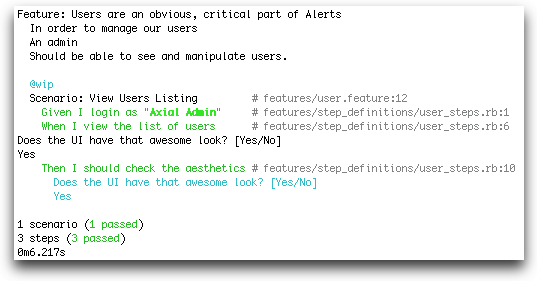John Nunemaker wrote a very nice article on assorted tips that improved his code… One of which revolved around naming.
Regarding naming… I absolutely agree. It is worth arguing about. The more critical the class is to the system design, the more I might go to the mat and wrestle a good name to the ground. The decision on a name can be a fleeting event, but it will have everlasting impact. Think: Write Once, Read Many. Don’t screw it up for the rest of us!
For a C++ app for manufacturing (’95-98), I employed a very layered architecture. Portable business objects were sent to the thin client (no UI talking to DB crap allowed!). The paradigm of pick lists was commonplace… show me a list of parts. The list UI component merely needed a set of IDs and Names. So each domain class could basically implement the interface and they too could be tossed into a drop-down list. My clever name for this little device never grew past “IdString” — we kind of joked about it, because a better name never surfaced.
When I see something like “GaugeAttributeServiceWithCaching” in isolation, it is not as easy to unilaterally discuss a better name.
However, were this inside a basic system called “Gauge” and I saw a bunch of other classes prefixed with “Gauge” — I would throw a red flag.
BTW: My rules are strict for domain-y things, and less strict for utility classes, and lesser things.
I mostly dislike prefixes, postfixes, redundant things of any sort in a name — class or attribute. If I have to mentally strip off a prefix to get at the gist of what I am reading, then it should not be there in the first place.
For example (non-Ruby community, mostly):
- column names prefixed by the table name (Table User; user_first, user_last)
- public class attributes prefixed by an underscore (Class User; string _first, string _last)
I also raise an eyebrow and look more closely at any (domain) class ending in “er.” Yup. Try it. Look for some. They are usually “doing” things.
You can go too far in making “God” classes that have no properties of their own, are stuffed full of collaborators via the initializer, and wouldn’t know how to delegate if it hit them over the head. It’s the kind of “Manager” class (there’s that ‘er’) that — instead of asking (delegating) for it’s gauges to compute some stat, it gets all the data from the gauges and does the work for the gauges. Don’t be that guy!
Conversely, look for the boring data class. No methods, just accessor stuff. While it might be just fine, and there truly is no business logic for this class, I would look around just to be sure there are no over achiever “er” classes lurking in the dark alleys — ready to pimp the business logic for the data class.
Thanks for sharing, John!


